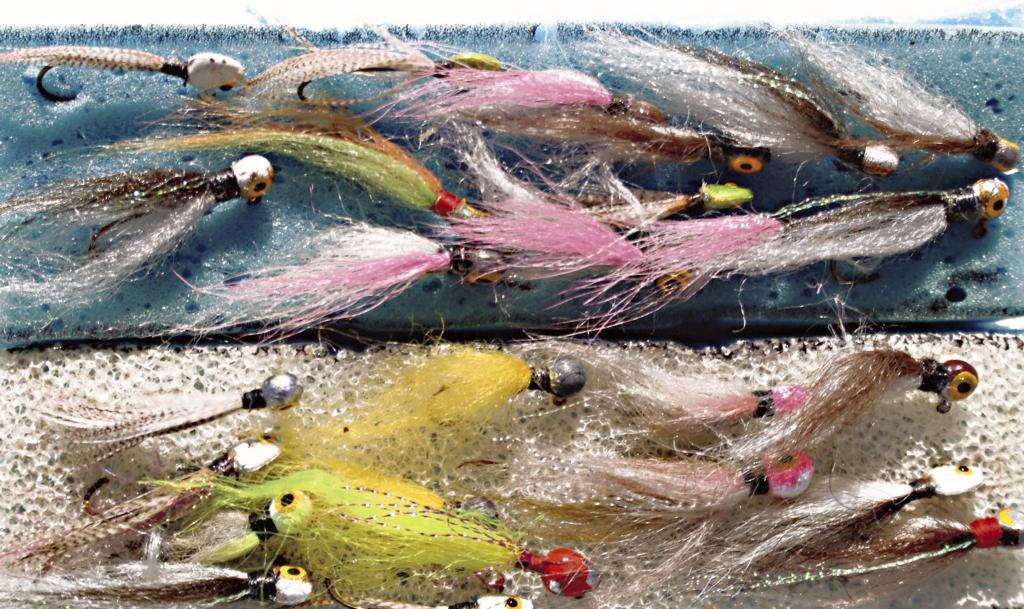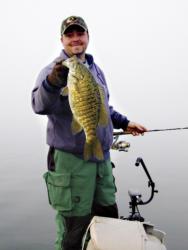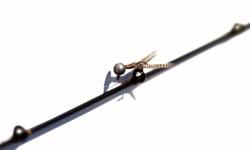Float ’N Fly
Winter fishing technique giving bass anglers reason to go fishing during coldest months of year

Winter is a challenging season for bass anglers.
The water is cold, and bass are sluggish, reluctant feeders that spend much of their time suspended in deep water.
Combine these fishing conditions with the possibility of snow, high winds and daytime temperatures in the 30s, and it’s not hard to understand why so many anglers stop fishing as soon as cold weather hits.
But a winter fishing technique perfected in Tennessee in the early 1990s is giving bass anglers in the central United States a reason to go fishing during the three coldest months of the year, December through February.
It’s called Float `N Fly
This innovative way of catching quality bass has been embraced by Bob Coan, John Davis and other fishing guides on 27,700-acre Dale Hollow Lake, which straddles the Kentucky/Tennessee line.
The finesse presentation targets suspended fish and is most productive on smallmouth and spotted bass.
Float ‘N Fly originated in the clear lakes of eastern Tennessee and was discovered by accident, by fishermen who were trying to catch crappie.
The term Float ‘N Fly is a bit misleading because it’s really a jig and bobber rig with a 1/32-, 1/16- or 1/8-ounce lead-head jig fished on a long leader below a 1-inch plastic, float.
There’s good reason to be skeptical at first, because it’s hard to imagine being able to consistently catch large bass on such a small jig. After fishing the Float ‘N Fly for three winters, however, there’s no question in my mind that it’s a big fish presentation. Rarely are bass less than 16 inches taken.
Coan believes the technique can be productive anywhere, in any lake or river, provided that conditions are right – there’s clear water and water temperatures are below 50 degrees.
In the winter of 2002 my son and I proved this point when we caught several 3-pound smallmouths and a 4-pound largemouth in a couple of hours on the Float ‘N Fly from the Kentucky River, a rocky river that flows through central Kentucky. The river was low and very clear, with a water temperature of 46 degrees.
 “The ideal scenario is a front with wind, which helps break the surface and creates current,” said Davis, who has been winter fishing on Dale Hollow Lake since 1994. “The toughest fishing is on calm, clear days. You have to fish shady banks and generally you won’t catch big numbers of fish.”
“The ideal scenario is a front with wind, which helps break the surface and creates current,” said Davis, who has been winter fishing on Dale Hollow Lake since 1994. “The toughest fishing is on calm, clear days. You have to fish shady banks and generally you won’t catch big numbers of fish.”
In Kentucky, the Float ‘N Fly is still a relatively local technique, most popular on Dale Hollow Lake and nearby Lake Cumberland. Both Dale Hollow and Cumberland have big populations of smallmouth and spotted bass, super clear water, lots of the steep rock walls on the main lake and bottom structure in coves that is reachable at winter drawdown.
Water temperature has a big impact on fishing depth. “Water temperatures must be below 50 degrees, but actually the cooler the water, the shallower the fish get,” said Coan. “In early December, as the water is cooling down, I might have to fish as deep as 15 feet, but most of the time through the winter months, my jig is fished about 10 feet below the float.”
The effectiveness of the technique is not hampered by snow, severe cold fronts or low water temperatures. A few winters ago, during an extended cold snap, Coan said he caught bass in water that was 36 degrees. “Cold fronts play right into this scenario, because the colder the water, the more bass suspend,” he said.
Coan concentrates on fish suspended in submerged creek and river channels and fishes out 10 to 15 feet from the banks. “I fish bluffs, points and steeper banks near channels,” Coan said. A typical situation has the boat over 45 feet of water and anglers casting to banks where the water is more than 20 feet deep.
Coan also looks for downed trees whose tops are out in deeper water over channels. “Bass will suspend all around a tree top,” he said. “On an overcast day they’re out on the perimeter.”
Davis’ approach to fishing the Float ‘N Fly is a bit different in terms of the banks he fishes, their depth and the distance he fishes from the bank. He thinks that bass travel around less during the winter but move up and down more in the water column and tend to congregate in small areas. “You can cast your jig 10 feet either way and not get a bite,” he said.
Davis is not afraid to look for less obvious structure in open water, far from the banks. “In a lot of situations I think bass are relating more to the bottom than the bank, such as humps on broad flats,” he said.
Davis makes long casts and fishes these areas thoroughly. And he is likely to be fishing out in the middle of a big creek if he finds small ditches, dropoffs, rock piles or weed beds. He also fishes cuts and irregularities in the banks, rock slides, or transitions in the bank composition.
 Most anglers tie their own jigs. Float ‘N Fly jigs are lead-head jigs tied with bright-colored craft hair and strips of shiny synthetic materials that add flash so that the jigs imitate bait fish – gizzard and threadfin shad or alewives. Use as big a hook as possible when pouring jig heads. I prefer a bronze finish No. 4 on a 1/16-ounce jig.
Most anglers tie their own jigs. Float ‘N Fly jigs are lead-head jigs tied with bright-colored craft hair and strips of shiny synthetic materials that add flash so that the jigs imitate bait fish – gizzard and threadfin shad or alewives. Use as big a hook as possible when pouring jig heads. I prefer a bronze finish No. 4 on a 1/16-ounce jig.
Coan ties all his jigs with red thread, and likes the natural color of lead rather than painted jig heads most of the time. “I put a clear coat on the jig head to prevent the lead from oxidizing (and turning white),” he said.
Color is an individual preference. I have had the best luck tying jigs with combinations of gray, white, silver and chartreuse, using gray or white thread and feathers instead of craft hair. My personal choice is white maribou, with chartreuse hackle and blue/silver flash to imitate a threadfin shad.
Don’t, however, be afraid to fish bright colors. Davis is especially fond of a pink and orange craft-hair combination. Bright colors are a good choice on overcast days or foggy mornings.
The idea is to create a jig that fluffs out and undulates, giving it the appearance of a buoyant, live minnow.
To fish the rig, cast the bobber and jig toward the bank and allow the jig to settle. Watch the float closely for strikes. Most strikes are rather subtle. The bobber might spin, fall over on its side, move off, or simply ease under the surface.
A 9- to 10-foot spinning rod with light to medium action is needed to cast the rig because the leader is so long. The cast seems a bit awkward at first but not hard to learn. Sweep the rod back sideways and wait to hear the jig hit the water behind you, then sweep the rod forward to your target.
Once the jig has settled, raise the rod tip and start jiggling the rod, which makes the bobber dance in place. This will make the tiny jig, suspended below the bobber, vibrate and quiver. While continuing to twitch the rod tip, slowly reel the bobber back to the boat.
Wind (blowing into the bank) is helpful to the presentation, which relies on subtle movement to trigger strikes. “Tiny waves make the bobber rock back and forth, giving action to the jig,” Coan said.
Davis suggests using the wind to drift the jig over target cover in coves and across board flats.
Coan said the rig’s effectiveness comes from the fact that in cold water a bass isn’t going to chase anything. “The jig is right in front of the fish’s nose and looks like an easy meal,” he said.
Bass that are a few feet below the jig, or suspended at the same level, don’t have to expend much energy to grab it. “I think they believe it’s a dying minnow, or one that’s thermally stressed and can’t escape. It’s helpless looking and they grab it,” Coan said.
Thin, strong fishing line is also important to the success of fishing the Float ‘N Fly. While fluorocarbon line might seem like the best choice in clear water because it’s invisible, fluorocarbon is difficult to use as the main line in very cold water because it kinks and gets stiff.
Coan prefers to fish with a low stretch 8-pound line and fluorocarbon leader, and Davis’ choice is 6-pound monofilament.
There’s another important difference in the way Coan and Davis the for Float ‘N Fly. Coan uses a small brass three-way swivel to connect the line, leader and bobber.
Davis prefers to wrap his line around the brass stem of the bobber. “I wrap it three times so it won’t slip, but you’ve got to check the line frequently (for nicks) and re-tie after every fish,” he said.
One last tip. Take along a fishing buddy, because it’s nearly impossible to land a big smallmouth or football-sized spot by yourself when fishing the Float ‘N Fly. “When you reel the bobber up to the tip of the rod and you’ve still got 10 feet of line out, you need someone to put a landing net under the fish,” Coan said. “You can’t reach that far by yourself, and if you grab the line, the fish is probably going to break you off.”